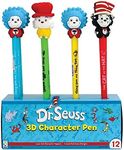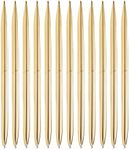Buying Guide for the Best Pens For Left Handers
Choosing the right pen for left-handers can make a significant difference in writing comfort and legibility. Left-handed writers often face unique challenges such as smudging ink and awkward hand positions. To find the best pen, consider factors like ink type, grip design, and pen tip. Here’s a guide to help you navigate through the key specifications and find the perfect pen for your needs.Ink TypeInk type is crucial for left-handers because it affects drying time and smudging. Gel and rollerball pens tend to have wetter ink that can smudge easily, while ballpoint pens have quicker-drying ink. For left-handers, quick-drying ink is preferable to avoid smudging. If you prefer gel or rollerball pens for their smooth writing, look for those specifically labeled as quick-drying.
Grip DesignThe grip design of a pen can significantly impact comfort, especially for left-handers who may hold the pen at different angles. Ergonomic grips that are cushioned and contoured can reduce hand fatigue and improve control. Look for pens with a comfortable grip that fits well in your hand, and consider trying out different shapes to see what feels best.
Pen TipThe pen tip affects the smoothness and precision of writing. Fine tips (0.5mm or smaller) are great for detailed work but may require more pressure, which can be tiring. Medium tips (0.7mm) offer a balance between smoothness and control, while broad tips (1.0mm or larger) provide a bolder line but can be messier. Choose a tip size based on your writing style and the level of precision you need.
Smudge ResistanceSmudge resistance is particularly important for left-handers to ensure that their writing remains clean and legible. Some pens are designed with special ink formulas that resist smudging. Look for pens that advertise smudge-proof or quick-drying ink to minimize the risk of smudging as you write.
Retractable vs. CappedRetractable pens are convenient because they can be operated with one hand and don’t require a cap that can be lost. Capped pens, on the other hand, often have a more secure seal to prevent ink from drying out. Consider your preference for convenience versus ink longevity when choosing between retractable and capped pens.
DurabilityDurability is important if you plan to use the pen frequently or carry it around with you. Pens made from sturdy materials like metal or high-quality plastic are more likely to withstand daily wear and tear. Consider how often you use the pen and in what environments to determine the level of durability you need.


















